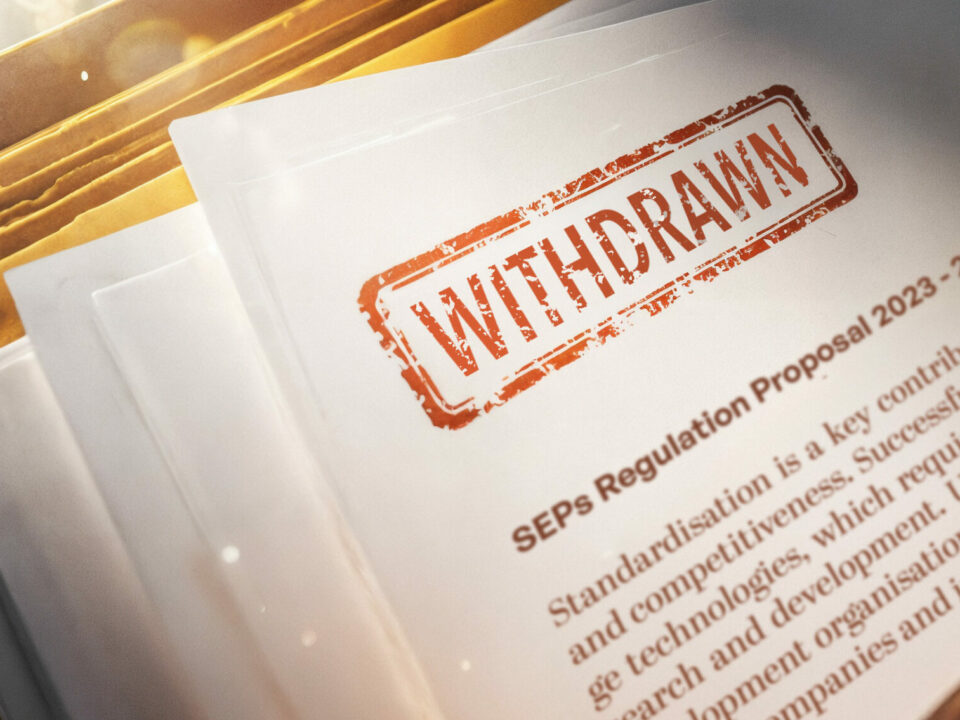World SME Day: Q&A With Fractus CEO Rubén Bonet
To celebrate this year’s World SME Day, June 27, we talked with our SME Chair, Rubén Bonet, CEO of Fractus, about the importance of intellectual property (IP) for small- and medium-sized businesses. We also discussed IP protection in Europe and the European Commission’s proposal for a regulation on standard-essential patents, or patents that are essential to the implementation of an open technical standard.
Fractus was a pioneer in the development of internal antennas for smartphones. The company holds an IP rights portfolio of more than 40 inventions protected by more than 120 patents and patent applications. It has received numerous awards and honours for its work and has a proven track record in innovation and licensing its award-winning, geometry-based antenna technology to wireless device manufacturers world-wide.

What are a couple of the most important inventions that Fractus has patented?
Fractus’ inventions are all about antenna technology, and each one is amazing in its own way, so it’s hard to say one is more important than another. However, if we had to mention a couple, we could talk about the first technologies we developed and the latest ones: the Multilevel antenna and the Multifunction wireless device, respectively.
The Multilevel antenna was one of the first technologies Fractus developed back in 1999. It was a groundbreaking solution for creating multiband and small antennas for things like mobile phones, satellites, and base stations. It allowed mobile phones to have internal antennas instead of big, external ones, and it would work everywhere in the world. This meant you could use the same phone in different countries, like China and Europe, without needing a new one, because it could handle different frequency bands. This technology was so important that it quickly became popular.
The Multifunction wireless device is a more recent invention that helps design antennas that are both multiband and small, making them perfect for the new generation of wireless devices.
Fractus has always provided groundbreaking solutions to problems in wireless communications and connectivity.
How important are intellectual property (IP) rights for Fractus overall?
Intellectual property rights are the core business of the company. IP rights are our most important assets.
At the beginning, Fractus was a Deep Tech company. We had an industrial business model and protected our inventions with patents. After a period of time Fractus shifted to an IP business model because of different infringements from which our antenna technology suffered.
Fractus has developed a portfolio of more than 40 different inventions protected through more than 120 patents and patent applications worldwide.
The number of licensees has increased over time, generating more than $200 million in royalties with two licensing programmes. The technology has penetrated in different verticals, going from the initial smartphone market with licensees such as Samsung, LG, Motorola and Blackberry (to mention just some of them), passing through the telecom infrastructure with Commscope and more recently jumping to the Internet of Things and health care.
What % of your revenues do you re-invest in R&D?
R&D is where we invest the most. Historically around 85% of our recurring expenses are related to R&D projects.
At Fractus, we invest so much in our own research—which we have always done and we want to continue doing—and also in Deep Tech research projects with important universities in our country, such as the Universitat Politècnica de Catalunya, where we have a Deep Tech research Hub, and Universitat Pompeu Fabra, with whom we created a chair to promote technology transfer and research in 6G development, for example.
What is your advice to other SMEs weighing the pros and cons of patenting their inventions?
My advice for the SMEs would be to keep on working for your inventions and make your own cathedral of patents a central focus of your business strategy. That’s because patents, as valuable assets, can bring your business many benefits:
- They have the power to attract investors
- They have the power to leverage your technology and allow you a competitive advantage in the market
- They have the power to show your reputation and brand strength
- They have the power to generate revenues through licensing agreements.
Do you feel that the European system of patent laws and regulations sufficiently protects intellectual property rights?
Fractus has experience in using many patent systems to develop its patent portfolio worldwide. Probably we have used the European and the American patent systems the most.
Overall, the European patent system provides strong protection for intellectual property rights. The establishment of the Unitary Patent and the Unified Patent Court (UPC) represents a significant step forward in addressing previous challenges related to fragmentation and enforcement. However, there is always room for further improvements to enhance accessibility, reduce costs, and expand the scope of patentable innovations.
The European Patent Office (EPO) has made significant advances in ensuring that inventors and companies can secure patents across multiple jurisdictions with a single application. However, there are several key points where enhancements could bring greater benefits to innovators and businesses within Europe:
- Speed and Efficiency: The U.S. patent system is well-known for its relatively quicker examination process. The EPO could benefit from further streamlining its processes to reduce the time taken from application to grant. This would help inventors and businesses capitalise on their innovations more swiftly.
- Patent Scope and Clarity: The U.S. system tends to be more permissive in the scope of patentable subject matter, including software and business methods. Expanding the scope of what can be patented in Europe, while maintaining rigorous examination standards to ensure quality, could encourage more innovation and investment.
- Cost-Effectiveness: While the EPO’s system is more cost-effective than obtaining separate patents in multiple countries, the overall cost, including translation and maintenance fees, can still be prohibitive for SMEs and individual inventors. Adopting measures to reduce these costs would make the patent system more accessible and attractive.
It would be important to highlight that the European Patent Office (EPO), with the implementation of the Unitary Patent System, has advanced significantly in the following points:
- Uniformity and Simplification: The Unitary Patent System, with its centralized application process and the establishment of the UPC, directly addresses the issues of uniformity and simplification in patent enforcement across Europe. By providing a single, streamlined process for obtaining and enforcing patents, it offers stronger and more predictable protection for intellectual property rights, much like the system in the United States. This harmonized approach enhances legal certainty, reduces costs, and makes it easier for innovators to protect their inventions across multiple European countries.
- Non-fragmented patent system: A non-fragmented patent system provides uniform protection, reduces costs, simplifies legal processes, enhances legal certainty, promotes innovation, improves competitiveness, and reduces administrative burdens, thereby benefiting the entire European economy.
Fractus doesn’t have any standard-essential patents, but you say the current European debate over SEPs affects you, too. Why is that?
Fractus patents are not SEP related. Having said that, I can give my opinion on how this regulation will affect the ability of European companies to innovate and compete in the global market.
For European companies this regulation means unnecessary political intervention into the markets and for me it generates a lot of questions.
While this regulation aims to create a more transparent and fair SEP licensing environment, it means significant challenges for SMEs in terms of increased bureaucracy, costs and complexity in licensing discussions.
SMEs that own SEPs will need to register their patents and undergo essentiality checks. This will create a lot of bureaucracy; it may discourage innovation and participation in standard development due to the increased administrative requirements.
This regulation introduces a mandatory but non-binding out-of-court FRAND process for licensing disputes, ostensibly in order to smooth negotiations and reduce litigation. But SMEs will require legal representation for that process, which carries a cost. And if the dispute is not resolved it may end up in court anyway.
How do you feel about the European Commission’s proposal for a new Regulation on Standard-Essential Patents?
Well, it is difficult to say if this regulation will help SMEs. I would say that there seems to be good intention, but definitely more work needs to be done.
There is a good intention in terms of trying to further improve transparency, for example. However, for a SME with limited resources and a small team will have to invest time in bureaucracy instead of in innovating in the labs or writing patents.
It seems strange that recognised authorities such as the EPO and the Unified Patent Court were left out of the proposal and that this newly established system would be handled by EUIPO, which has no expertise in patents.
Does this mean that SMEs will have to trust a system with the valuation of their patents with people who do not have expertise about patents and licensing, but who only care about obtaining a price? This doesn’t seem to be very fair, nor very objective indeed.
So, basically, what is happening here is that all these measures in this regulation will make our patent system weak. From the SME perspective, we cannot afford to weaken our patent system because this will seriously harm the competitiveness of SMEs in Europe and internationally. Now that we were starting to have an effective system with the Unified Patent Court and the Unitary Patent, we cannot throw away all these efforts.
Please remember what happened in the United States when the America Invents Act was approved in 2011. That was a turning point for the US patent system, which moved the balance towards the developers. It seems a very similar situation.




